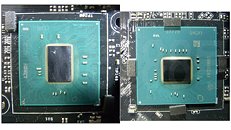Thursday, September 20th 2018

Intel to Move Select Chipset Fabrication Back to 22nm in Wake of 14 nm Silicon Constraints
Things seem to be taking turns to the worse at Intel in accordance to Murphy's law. Not only was the company hit with a multitude of security flaws embedded in their CPUs, which puts their michroarchitecture design chops in jeopardy, but now they also have to contend with silicon fabrication snags. That Intel's 14 nm fabs are being hit with overwhelming demand for their output capacity is already a known quantity, with rising prices of Intel mainstream CPUs and reports of the company outsourcing 14 nm chip production to TSMC in a bid to increase availability - a first since the company became vertically integrated with both design and manufacturing of their own chips.Now, reports are coming up that Intel will be moving some of its chipsets back to the 22 nm node - namely, the H310 chipset - so as to clear production capability from the 14 nm one. As you might remember, historically, Intel's chipsets have been one silicon manufacturing generation behind their CPUs. Due to the problems in Intel's 10 nm process and constrained output of their 14 nm process, this has now become a necessity again. The new H310 chipset, which had to be architecturally revised for 22 nm (which isn't as easy a thing as one might expect) will debut in the H310C or H310 R2.0 indicator. It will be physically larger (naturally) and incur in a small power efficiency loss as well, and - get this - support Windows 7, likely via asoftware/driver solution. Motherboards with the new chipset are already moving out into the supply chain.
Sources:
ETeknix, Tom's Hardware

75 Comments on Intel to Move Select Chipset Fabrication Back to 22nm in Wake of 14 nm Silicon Constraints
Who woulda thunk?
- CPUs
- Chipsets
- Wired network controllers
- Wireless network controllers
- SSDs
- Thunderbolt controllers
- Probably even more
I'm sure at least one of those types of chips is currently overstocked, and built on 22nm, so they have the tooling setup, and demand low enough to switch manufacturing over for an amount of time to cope.In fact if you go to the official page it shows "Lithography22 nm" for Z370 and 14nm for H310. The latter is more advanced.
Go figure, so they made the move for the first time in history to produce both CPUs and chipsets on the same node and this happened.
GET
YOUR S**T
SORTED ALREADY
You're making yourselves look like rank amateurs, not a silicon industry pioneer.
@Raevenlord , you should probably highlight words "chipset" and "H310" in bold, to make it easier for people with attention span of a hamster to jump to proper conclusions without reading the text. :D:D:D
Having an Intel PCH in a system, that is made on older process, makes nearly no difference. We've lived with that pretty much forever (only the recent 300-series being an exception). Back in a day a 45nm Nehalem and 32nm Westmere were paired with a 65nm chipset, 100/200-series were made on 22nm node. AMD has been making chipsets on 65nm process all the way 'till 2016, and even the latest Promontory is manufactured by AsMedia on 55nm fab (they've only started 32nm fabrication this year, but I could be wrong).
Given that the role and functions of a chipset or a platform hub are shrinking year by year, it won't make any difference (except for maybe 0.5W in peak power draw). Also, the only confirmed affected part is an H310 chipset, which is supposedly going to be called H310C.
… with respective actual nodes as of, dunno, pretty recently I guess?
At least some site on 10nm is designated, so it also could be from '15. Who knows …
That being said this matters little, it is though quite funny that they went through the troubler of bringing even their chipset on the latest node and now they have to go back.
"Things seem to be taking turns to the worse at Intel in accordance to Murphy's law. Not only was the company hit with a multitude of security flaws embedded in their CPUs, which puts their michroarchitecture design chops in jeopardy, but now they also have to contend with silicon fabrication snags "
Remember to always mention Intel's CPU security problems! :-D
What happens in real life:
1) Intel is moving chosen plants to 10nm,
2) They have a huge order portfolio, so they had to shuffle production sites a bit,
3) 22nm fabs will make H310C - the cheapest and simplest chipset in the lineup.
To be honest, I don't know why they moved to 14nm in the first place. All pre-Z370 chipsets were 22nm or older (yes, including X299 and C422) and it's not like they're low on features or anything.
Thing is, and speaking about happily shooting your on foot;
To my knowledge, that very law which demands computer peripheral components being energy-efficiency, Intel even happily was lobbying for and was actively involved in shaping such regulations. That why they proudly announced it joyfully in the first place. So their own actions are now coming back to bite their ass.
Did I mention that I love boomerangs?? Their ways are so friggin‘ predictable!
We're writing the Year two thousand and eightteen as we witness when Intel shots their own face …